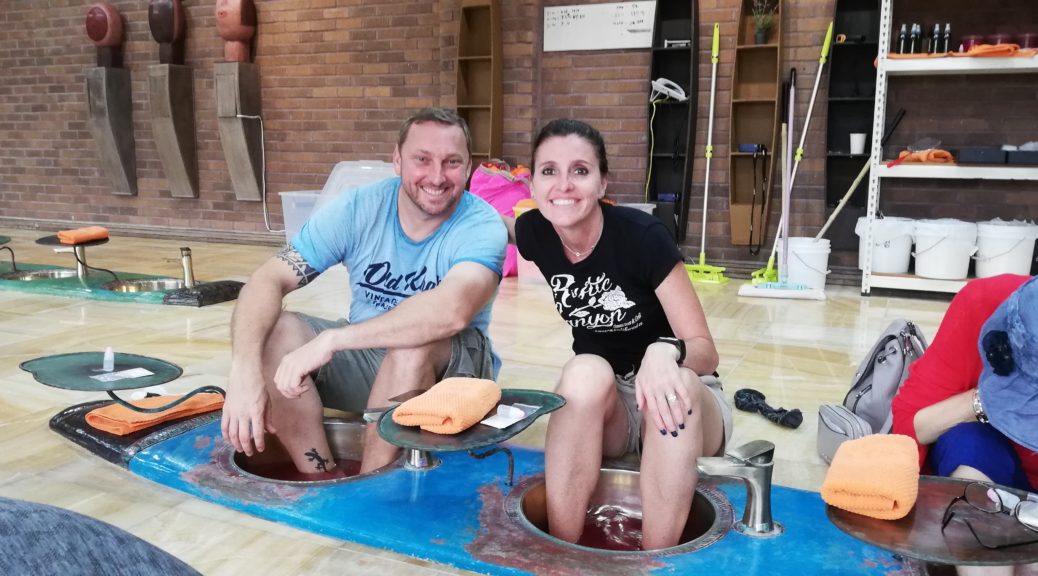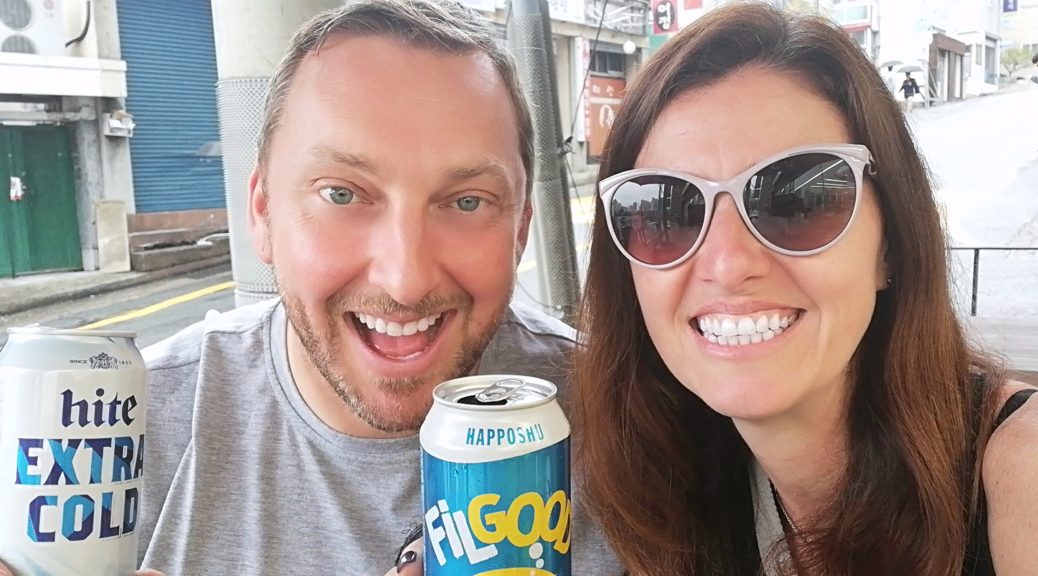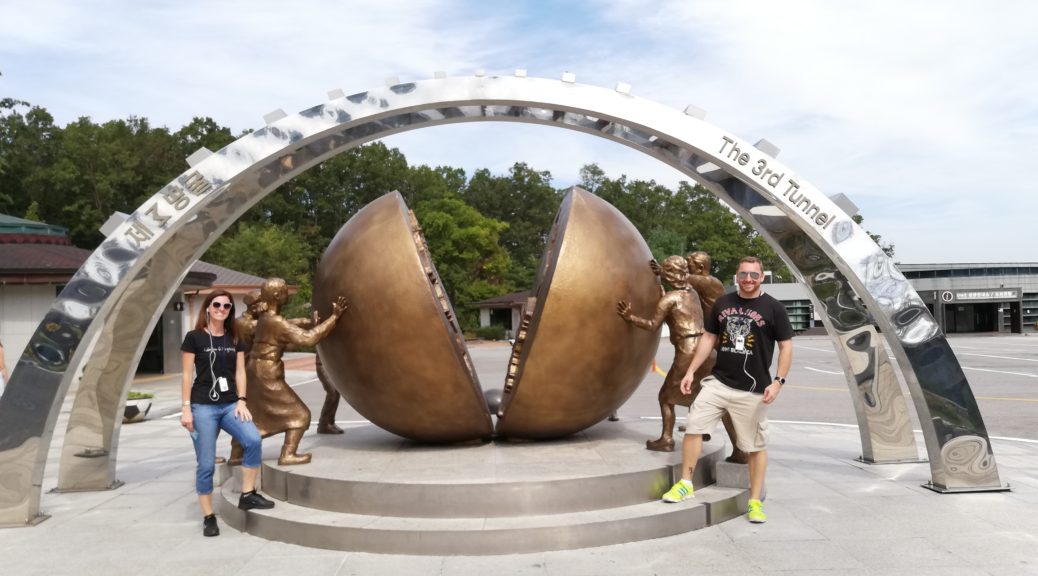JEJU
29 September – 01 October 2019
After having very nearly almost missed our flight from Busan, we were relieved to touch down on the runway in Jeju for the next leg of our trip.
Our hotel, a Ramada by Wyndham, was in the town centre of Jeju City, so it was an easy bus ride to get there. We only had large-note paper money so feared being turned away but the bus driver, taking pity on our bedraggled selves and big cases, waved us onto the bus for free instead. The wheel turned though when we got off a stop too early and had to haul ass uphill -and in the drizzling rain that had just started – to get to the Ramada sign that we could see in the distance but that seemed to not get any closer.
Having had quite a heavy weekend and with our East Coast tour starting early the next morning, we decided to play it safe with a tame dinner in our neck of the woods.
It was still lightly drizzling, which we hoped would lift for the next day, but which we knew better than to rely on the weather report for a forecast after the completely random predictions from the weekend in Busan that had seen 99% chance of rain be dry as a bone and 44% be the downpour that had come out of nowhere and drenched us.
Good fortune was on our side though and we awoke to blue skies. Well, patchy blue skies, but that would do.
We met our tour guide, Jin, who ran us through the order of events for the day, predicting rain for 15h00 and reassuring us that we’d be done with the outdoorsy stuff by then so it wouldn’t interrupt play for us.
Jin gave us a rundown on Jeju while we drove out of the city.
Geologically, Jeju Island was a shield volcano, first erupting 1.8 million years ago and continuing on and off until recent times. It was bigger than most think before they visit; 3 times the size of Seoul and almost 3 times the size of Singapore, so ideally tourists need 3 or 4 days to see the whole island.
There are 700,000 people living on Jeju and this number was growing with people coming to find a more balanced life than in the cities, like Jin himself who had moved down from Seoul. He spoke fondly of the life and culture on the island, proud that it had no beggars, no thieves and no gates. Jin called it a “cousin’s culture”, where everyone was proud of their heritage, worked to preserve it and looked out for their people – and he said it could be tough for outsiders such as himself to break into such a tight circle.
Jeju was also a self-governing province so visa-free for over 180 countries, saving the red tape for countries they term as dangerous, like Afghanistan. Otherwise they welcomed foreigners and if those foreigners purchased property for $500k or more they would get a permanent resident visa. The clearly progressive goverment was also pushing electric cars to try reduce pollution, so they subsidised up to 50% of the car’s purchase price to encourage more environmentally friendly road usage.
By this point in the story we had arrived at Manjanggul Cave, a volcanic lava tube that is 7km long, although the accessible bit is only a kilometre. Expecting it to be a narrow tunnel, it was a surprise when we took the steps underground to discover a massive cave.
The walkway had subtle lighting guiding the way, but it was still very dark because if they lit it too much then the moss would grow and ruin the cave, and the small lights could only brighten so much of the caves that were easily 3 or 4 metres wide and 5 or 6 metres high in mostly places, but also ballooned into much bigger caves periodically.
The info boards explained in layman’s terms why and how the caves and passages were formed so it was very interesting, even with no geological knowledge at all – and we could know what we were looking at with the likes of the 7.6m high lava column (formed when lava pours down from the ceiling and congeals; Jeju’s was the highest in the world) and Turtle Rock (a dried lava shelf that happens to be exactly the same shape as Jeju Island).
The caves were very cold (between 10 and 15 degrees) and dank, with water dropping from the ceiling so as much as it was a great experience, it was an equally great experience to resurface.
Jin told us that there had been citizens that had hidden in the caves during the genocide of the Jeju Uprising directly preceding the Korean War in 1948, where 10% of the population was killed in the process of trying the quash the rebels. I can’t imagine how awful that must have been!
The next excursion was a visit to the Jeju Gimnyeong Maze Park. We were provided a map and challenged to get to the bell in the centre. Constructed with over 2200 aromatic, green and very samey-samey Leyland Cypress trees, it was a fun challenge to twist and turn through the narrow leafy passages to complete the task.
Jin then took us to Woljeongri beach for a coffee stop to relax and admire the azure ocean and strip of golden sand beach. Fortunately, the weather had held so we were able to walk up and down the beach. With its fringe of shops and restaurants and idyllic waters, it was easy to see how this was described as a perfect holiday resort town.
Lunch was the next exercise and we were signed up to try the pork for which Jeju is famous; tender rashers marinated and served in a spicy basting. Jeju, however, was also infamous for another pork story, where old traditional houses used to use pigs as their sanitation systems. Outdoor toilets channelled the waste to adjacent pig pens, where the pigs would eat the matter and then of course later be eaten themselves. Quite efficient. But also very gross.
Rested and refuelled, we headed to Seongsan Ilchulbong for our hike up the crater. As a Tuff Cone Hydro volcano formed by the ocean about 5-7 thousand years ago and detached from the mainland, what has evolved and remains today was a perfect dormant crater easily accessible from the island which, after climbing the 553 stone steps to get to the top, allows spectacular panoramic views of the island, neighbouring Udo island and the ocean. Completely worth the effort.
At the bottom of the crater was a cove where the Haenyeo lady divers can be seen. These (mostly old) ladies are known for diving for conches and abalones without any equipment. They sell their hauls and supply the restaurant in the cove, which I suspect must be some of the freshest seafood you’ll ever have the pleasure of eating.
Hot and sticky from our walk, we were surprised with a bonus stop that hadn’t been described on the itinerary; a lesson in aromatherapy massage.
We were led through very pretty and perfectly manicured gardens to a very Zen looking and sounding room which had rows and rows of golden basins sunk into the floor. Jin sat us down in an area facing a wall of glass window overlooking the gardens.
We were told to put our feet into the basins which were half-filled with scorching hot water. We could add a little cold, but were told to try and tolerate as hot as possible.
The water already had rosemary drops in it (so it smelt delicious since I only associate rosemary with roast chicken) and Jin squeezed in some rose and peppermint oils. The aroma off the hot water was heavenly!
Jin guided us through a series of breathing exercises, through nose-only first then deep breaths through mouth only, to use the scents to open up sinuses and chest. Then we were given salts to use to scrub feet, lower legs and then hands, ending off with a pat dry and rubbing rosemary moisturising oils into the bits we’d just exfoliated, while Jin drizzled a few drops of peppermint and rosemary oil on the top of our shoulders and back of the neck.
With feet glowing and shoulders buzzing, it seemed a shame to have to put socks and shoes back on to return to the bus pausing for commemorative photos in the pretty gardens en route.
Our last stop for the afternoon was the small village of traditional Jeju style houses. In an effort to preserve the heritage, the goverment pays for the repair of the houses so there are still people living in them to provide a living museum of sorts.
We saw the infamous pig-cleaning toilet setup (!!) and Jin showed us other adaptions that the Jeju people have had to make to adapt to their environment, eg with the island being very windy, they have to tie the thatched roof down with rope. Bearing in mind Jeju was expecting its 6th typhoon for the year on Wednesday (no doubt “44% chance of…”), the government must have been shelling out pretty consistently to keep repairing these relatively fragile constructions, so good on them for their continued commitment.
With the tour done and so much seen, we were herded to the bus to try and get ahead of the dreaded rush hour traffic on our return to town. The driver put foot to get us there, as the rain started. Jin’s prediction had been off by a couple of hours, lucky for us.
It was tough choice to decide what to have for our last supper in South Korea, but we settled on Chicken & Beer as a sure winner. We consulted Google Maps and got to a very traditional (and by traditional I mean ‘no English menu’) restaurant. It took some charades and a translator app for us to muddle and order through, but we got the Soju and Cass right away so there was some wriggle room with the rest.
We needn’t have feared; we were served a massive platter of chicken – some crumbed and deep fried and some in a sticky sweet chilli sauce – with all sorts of side dishes. The kind of feast you need to just dive into sans reservations and then wet-wipe yourself back to presentable afterwards. Which we did.
Since the rain had started coming down harder while we were eating, we were compelled to get another bottle of Soju to wait out the storm and soak in our last night.


